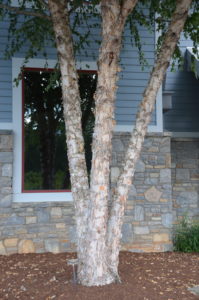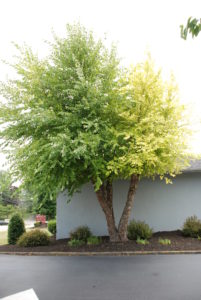In general, most species of our native birches (Betula spp.) grow best in cool, northern areas of the U.S. They are found growing along the sides of rivers, lakes, streams, and mountainous areas (USDA Zones 4-9). Most birches (not all) are recognized for their distinctive gray to white bark. Birch species with the whitest of bark are not heat tolerant, insect and disease prone, and usually are short-lived in zone 6 and points south.
Compared to other species of birch, river birch (B. nigra) is more heat tolerant and is highly insect- and disease-free (USDA hardiness zones 3-9). Heritage® and Duraheat® are two exceptional cultivars of river birch that have changed our overall view of the species. Both grow almost identically at 40 feet high and 30 feet wide. Catkin-like flowers swell over the winter months and open in early spring.
Both cultivars are mostly purchased multi-trunk with a broad pyramidal architecture. Summer foliage is medium green and glossy and turn bright yellow in the fall. Heritage and Duraheat were selected for their lighter colored bark and medium green glossy leaves. To date, Heritage is the more popular, but Duraheat is preferred in southern climes. The mottled peeling bark exposes patches of cream, orange and pinkish tan colors within. Both are highly resistant to bronze birch borer.
River birch prefers a moist slightly acidic soil, and once established, it adapts to moderately dry ground. Mulch with pine needles or pine bark to favor an acidic soil. Otherwise, leaves may turn chlorotic (yellow) in summer if soil pH runs slightly alkaline. Feed with a slow release fertilizer such as Osmocote™ or Nutrikote™ in early spring. If soil pH becomes alkaline, apply elemental sulfur or chelated iron (follow precise package directions). Birches are bleeder species and are best pruned in summer.
River birch trees grow rapidly and require minimal annual care. Tree exhibits 4-season landscape interest. They are often planted in parks, golf courses and other public areas. Homeowners plant clump-growing river birches around deck and patio areas. Fall leaves decay rapidly and are an easy clean-up.



 Posted in
Posted in 
